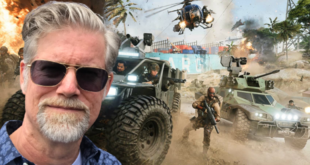It’s impossible to overstate what an incredible career opportunity being audio director on Star Wars Battlefront represents.
But having veto on literally everything that comes out of the speakers for a new interactive chapter in arguably the planet’s best-beloved franchise is also an awesome responsibility. Oh, and did we mention the PC version is the first Dolby Atmos-enabled game?
“With all new projects, I’m always a bit daunted about what lies ahead”, says DICE audio director Ben Minto. “But this is a very healthy reaction and a great internal measure to gauge how hard you’re willing to push yourself; how much does this mean to you?
“With something so iconic as Star Wars, we knew we needed the original John Williams score, as well as access to the original sound effects and constituent source material.
“Our contacts at Lucas and Disney were amazing; EA quickly cleared the music rights and we were delivered 10 hours of Star Wars SFX. Going through it was a dream. Being able to hear the original recordings, complete with slates, was a humbling and unique experience that highlighted just how fortunate we were to work with such sacred material.”
MEET THE MASTERS
The team even attended an ‘audio summit’ at Skywalker Ranch, meeting with the masters behind Star Wars’ sound design: Ben Burtt and Matt Wood. Together, they discussed how to respect and honour the duo’s legacy, whilst extending it to cover all DICE’s needs.
“They were really impressed with how we work in the Frostbite engine,” Minto recalls. “Subsequently, they provided access to stems from the first six films: music, sfx, dialogue, aliens and so on. We also sent detailed requests for SFX ‘pulls’ – where we knew it might be hard to isolate them or where we needed many variants.
This provided many new and perfect source elements.
“We also undertook a set of foley sessions with Dennie Thorpe and Jana Vance, to help get us the right source for the movement and surfaces sounds; we then made our own unique sounds combining these recordings, new recordings – for example, Icelandic lava fields for the Sullust levels – and material from our own huge DICE library.
“The audio benchmark, which was easy to set, was of course the original trilogy; if it ‘sounded like the films’ – no mean feat – then we had achieved our goal. A simple extension to this was to embrace the Star Wars source material, legacy, methods and be true to its origins. That is: don’t create new, build on what exists.
“Next, we had to extend from these starting points to make all sounds sit together in the world, as part of the same family. This was some critical learning from working on Battlefield for eight years. Finally, we enhanced the aural experience by utilising as much from the Star Wars universe as possible to really flesh out and enrich
the soundscape beyond the visually verifiable and fill the game with plenty of audio ‘nods’.”
PAINTING BY NUMBERS
In films, a single sound might be reused many times and involve one perspective – for example, most blaster shots are ‘third-person’ and fairly close – but DICE needed to extend from that to cover ‘first-person’, various distances and also model how the blasters sound in different environments.
This entailed deploying old studio technologies, including vintage analogue synths – some favourites of Minto’s. Parts of the project he describes as “like painting by numbers”, given that they were working with a very specific, defined audio scenario, but huge swathes of the canvas were blank. The team’s goal was to make everything – old and new – stick together as one coherent soundscape that made sense and was believably ‘Star Wars’.
“It was an incredible title to work on and, for me, the only way to approach this immense project was the humble Swedish/DICE modus operandi,” says Minto. “I was constantly thankful for working with such a great team, on such an awesome project and with all the support you could ask for, to help us do our very best.”

 MCV/DEVELOP News, events, research and jobs from the games industry
MCV/DEVELOP News, events, research and jobs from the games industry



